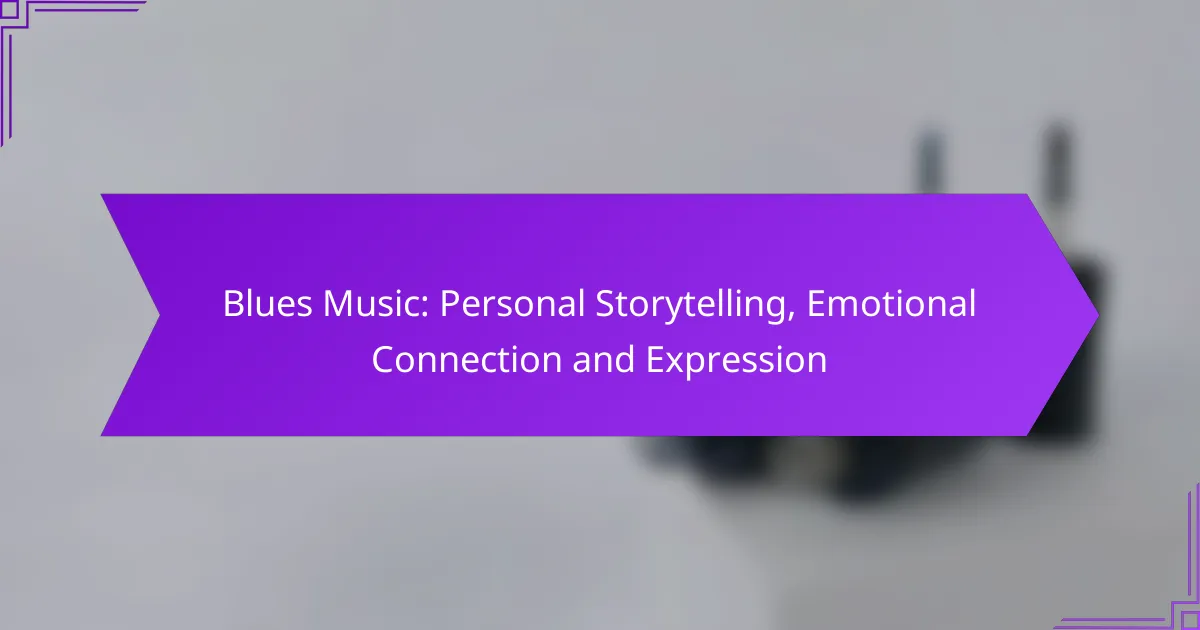Blues music serves as a powerful medium for personal storytelling, weaving rich narratives that reflect the artist’s individual experiences and emotions. Through its evocative lyrics and melodies, the genre fosters deep emotional connections, allowing listeners to resonate with the struggles and triumphs expressed in each song. This unique blend of storytelling and musical expression creates a profound bond between the artist and the audience, making the blues a timeless form of emotional communication.
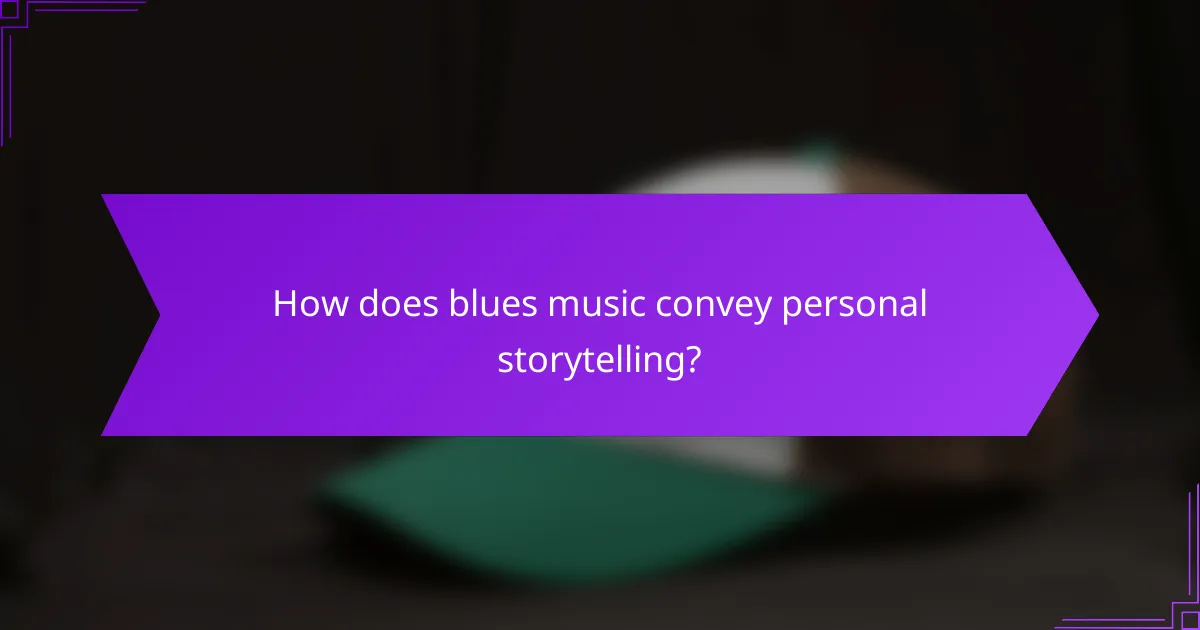
How does blues music convey personal storytelling?
Blues music conveys personal storytelling through its rich lyrics that reflect individual experiences, emotions, and struggles. This genre often uses narrative techniques to connect deeply with listeners, allowing them to resonate with the artist’s journey.
Lyric themes of struggle and resilience
The themes of struggle and resilience are central to blues music, often depicting hardships such as heartbreak, poverty, and discrimination. These lyrics serve as a cathartic outlet for artists, transforming personal pain into powerful narratives that resonate with a wide audience.
For example, songs may explore the emotional toll of lost love or the challenges of overcoming adversity. This focus on real-life struggles fosters a sense of solidarity among listeners, who may find their own experiences reflected in the music.
Influence of personal experiences on songwriting
Personal experiences significantly influence blues songwriting, as artists draw from their own lives to create authentic and relatable music. Many blues musicians share stories of their upbringing, relationships, and life challenges, which adds depth and sincerity to their work.
For instance, a musician who has faced economic hardship might write lyrics that highlight the daily struggles of making ends meet. This authenticity not only enhances the emotional connection with the audience but also preserves the cultural heritage of the blues genre.
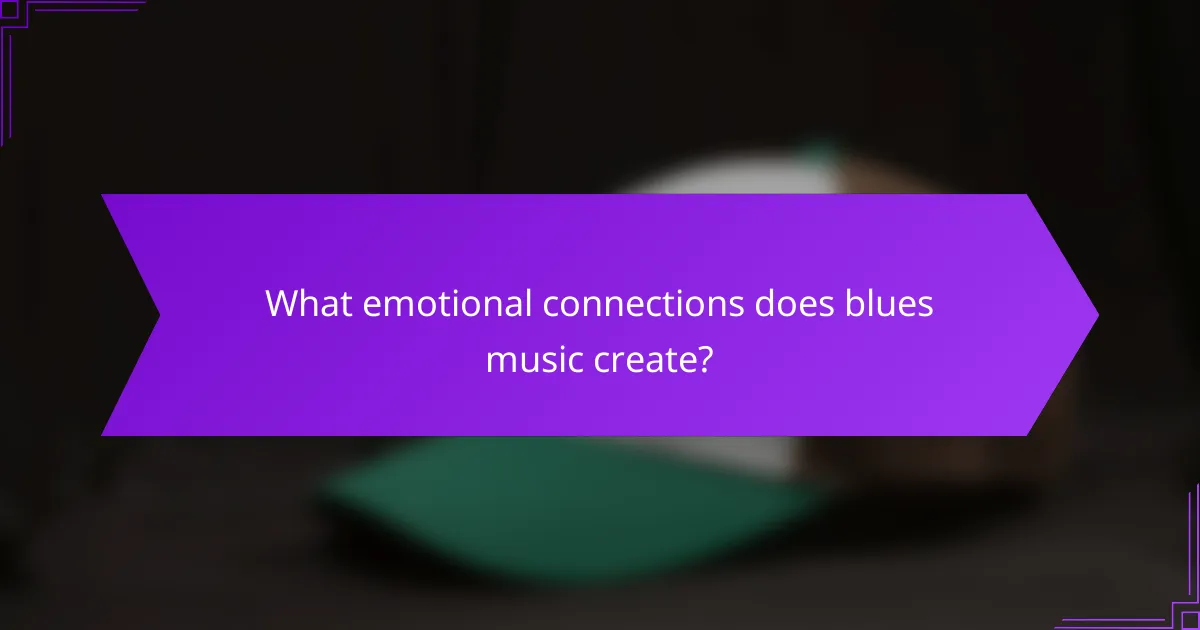
What emotional connections does blues music create?
Blues music fosters deep emotional connections by expressing feelings of pain, joy, and resilience through personal storytelling. This genre resonates with listeners, allowing them to relate to the experiences conveyed in the lyrics and melodies.
Empathy through shared experiences
Blues music often narrates stories of hardship, love, and loss, which many listeners can relate to on a personal level. This shared experience creates a bond between the artist and the audience, fostering empathy and understanding. For instance, a song about heartbreak might evoke memories of similar experiences in the listener’s life, making the music feel more intimate.
Artists like B.B. King and Muddy Waters have used their life stories to connect with audiences, illustrating how personal struggles can resonate universally. The authenticity in their lyrics invites listeners to reflect on their own experiences, enhancing the emotional impact of the music.
Impact of vocal expression on listener emotions
The vocal delivery in blues music plays a crucial role in shaping the emotional landscape of a song. The use of techniques such as bending notes, growling, and varying pitch can evoke a wide range of feelings, from sorrow to joy. For example, a singer’s raw, powerful wail can convey deep pain, while a lighter, more playful tone might express happiness.
Listeners often respond emotionally to these vocal nuances, as they amplify the storytelling aspect of the music. The combination of heartfelt lyrics and expressive vocals creates a rich tapestry of emotions, allowing the audience to feel the artist’s journey and connect on a deeper level.

How can you express yourself through blues music?
Expressing yourself through blues music involves conveying personal stories and emotions using musical elements and lyrical content. The blues genre allows artists to share their experiences, struggles, and feelings, creating a deep emotional connection with listeners.
Techniques for songwriting in blues
Songwriting in blues often revolves around storytelling, focusing on themes of heartache, resilience, and everyday life. A common technique is the use of a simple structure, typically following a 12-bar format, which allows for easy improvisation and expression.
When crafting lyrics, consider using vivid imagery and relatable experiences. Incorporating repetition and call-and-response patterns can enhance the emotional impact and engage the audience. Don’t shy away from personal anecdotes; they can resonate deeply with listeners.
Instruments that enhance emotional expression
Key instruments in blues music include the guitar, harmonica, and piano, each contributing to the genre’s emotional depth. The guitar, often played with a slide, can produce a soulful sound that conveys longing and pain. The harmonica adds a raw, expressive quality that complements vocal storytelling.
Using these instruments effectively involves understanding their tonal qualities and how they can evoke specific feelings. For instance, a slow, bending note on the guitar can express sorrow, while a lively harmonica riff can convey joy. Experimenting with different techniques, such as fingerpicking or using a bottleneck, can further enhance emotional expression in your music.
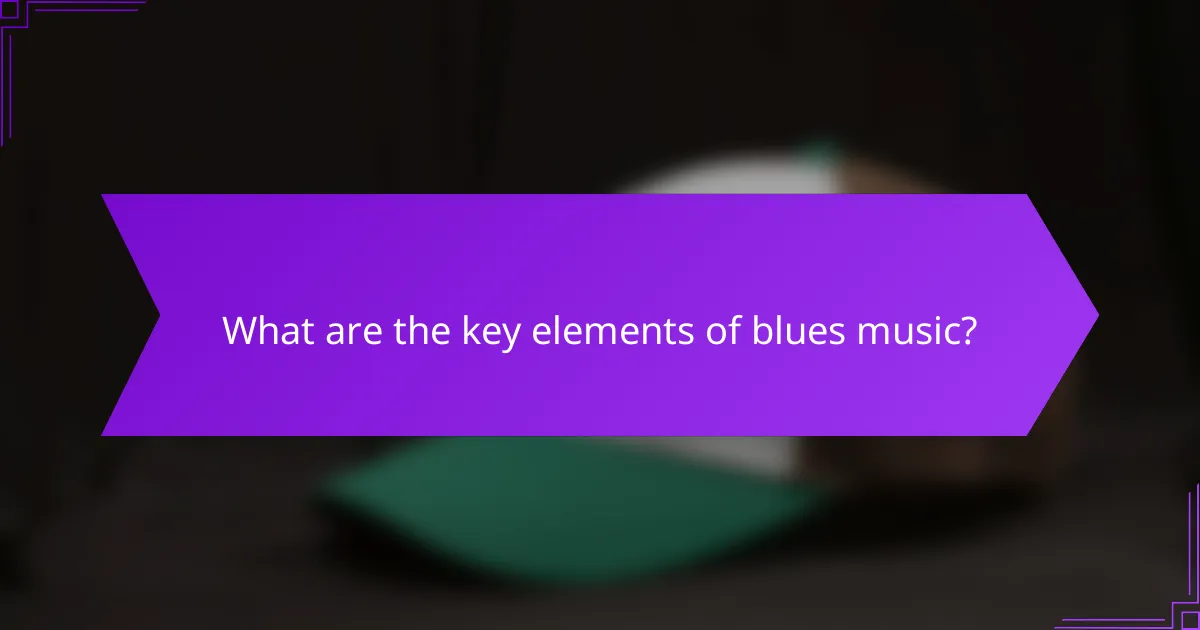
What are the key elements of blues music?
The key elements of blues music include personal storytelling, emotional expression, and a distinct musical structure. Blues often conveys deep feelings through lyrics and melodies, allowing artists to connect with their audience on a profound level.
Structure of blues chord progressions
The structure of blues chord progressions typically follows a 12-bar format, which is foundational to the genre. This progression usually consists of three chords, often referred to as the I, IV, and V chords, creating a cyclical pattern that supports improvisation and lyrical storytelling.
A common example of a 12-bar blues progression in the key of E would be E7 (I) for four bars, A7 (IV) for two bars, E7 (I) for two bars, B7 (V) for one bar, A7 (IV) for one bar, and E7 (I) for two bars. This structure provides a familiar framework for both musicians and listeners.
Importance of improvisation in performance
Improvisation is a crucial aspect of blues music, allowing musicians to express their individuality and emotional depth. During performances, artists often deviate from the established chord progressions and melodies, creating spontaneous solos that enhance the emotional impact of the music.
Improvisation not only showcases a musician’s skill but also engages the audience, making each performance unique. Musicians should practice scales and familiar licks to develop their improvisational skills, ensuring they can respond to the mood of the moment and the energy of the crowd.

How has blues music evolved in major cities?
Blues music has evolved significantly in major cities, reflecting local cultures and historical contexts. Each city has contributed unique styles and influences that shape the genre’s development over time.
Historical roots in Chicago blues
Chicago blues emerged in the 1940s, transforming the acoustic Delta blues into an electrified sound. This shift was largely due to the migration of African Americans from the South to urban centers, bringing their musical traditions with them.
Key figures like Muddy Waters and Howlin’ Wolf played a crucial role in popularizing this genre, incorporating electric guitars, harmonicas, and a strong rhythm section. The Chicago blues style is characterized by its use of amplification and urban themes, making it a staple in clubs and bars across the city.
Modern influences in New Orleans blues
New Orleans blues is known for its rich blend of influences, including jazz, R&B, and funk. This city’s unique cultural landscape has led to a more improvisational and lively approach to blues music, often featuring brass instruments and syncopated rhythms.
Artists like Dr. John and Kermit Ruffins exemplify the modern New Orleans blues sound, which often incorporates elements of storytelling and vibrant performances. The city’s annual festivals and live music scene continue to foster innovation within the genre, making it a dynamic hub for blues music today.
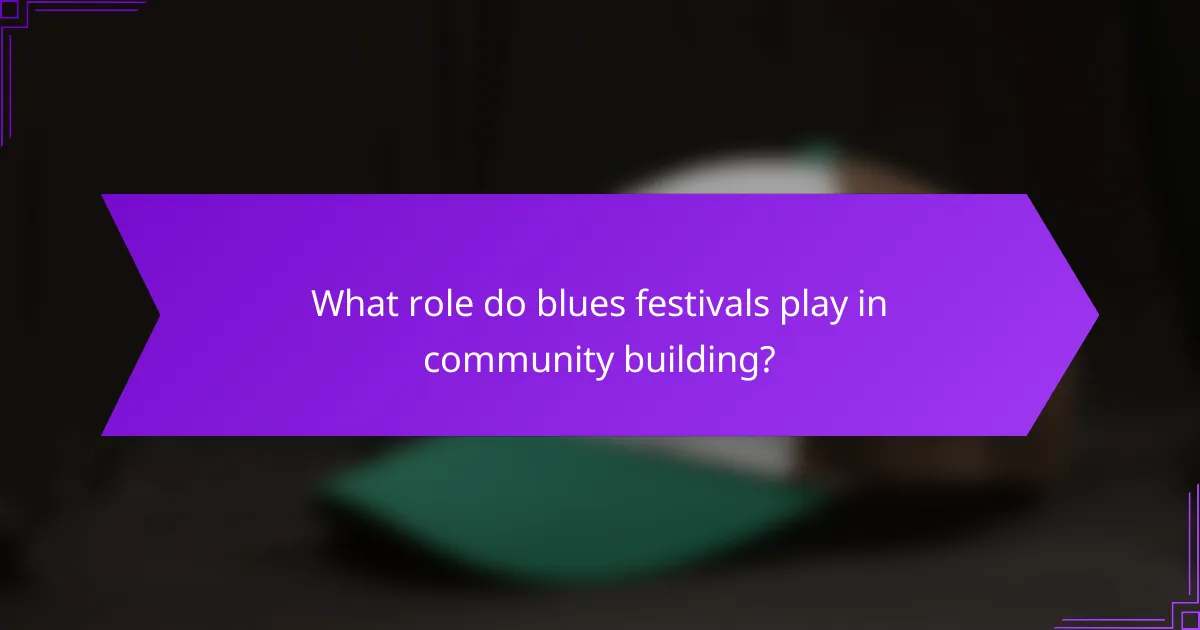
What role do blues festivals play in community building?
Blues festivals serve as vital platforms for community building by bringing together diverse groups of people through music, culture, and shared experiences. These events foster a sense of belonging and pride among attendees while promoting local artists and traditions.
Showcasing local talent and culture
Blues festivals highlight local musicians, allowing them to perform in front of larger audiences and gain recognition. This exposure can lead to new opportunities for artists, such as collaborations and bookings at other venues.
Additionally, festivals often incorporate local food, crafts, and traditions, creating an immersive cultural experience. This not only entertains attendees but also educates them about the region’s heritage and artistic expressions.
Fostering connections among artists and fans
Blues festivals create an environment where artists and fans can interact, fostering strong connections. Fans often have the chance to meet their favorite musicians, leading to memorable experiences and a deeper appreciation for the music.
Moreover, these events encourage networking among artists, which can lead to collaborations and community support. By building relationships, musicians can share resources, promote each other’s work, and strengthen the local music scene.

How can you choose the right blues music for emotional expression?
Selecting the right blues music for emotional expression involves understanding your feelings and finding subgenres that resonate with those emotions. By identifying personal emotional triggers and exploring various blues styles, you can connect deeply with the music and enhance your emotional experience.
Identifying personal emotional triggers
To choose blues music that resonates with you, start by identifying your emotional triggers. Reflect on moments that evoke strong feelings, such as joy, sadness, or nostalgia. Consider keeping a journal to note which songs or lyrics impact you the most.
Once you have a list of emotions, match them with specific themes in blues music, like heartbreak, resilience, or celebration. This alignment will help you select tracks that amplify your emotional state rather than detract from it.
Exploring different blues subgenres
Blues music encompasses various subgenres, each conveying different emotions and styles. Familiarize yourself with styles such as Delta blues, Chicago blues, and Texas blues, as they each offer unique sounds and lyrical themes. For instance, Delta blues often features raw, acoustic sounds that evoke deep sorrow, while Chicago blues tends to be more upbeat and electric.
Listening to a range of subgenres can help you discover which styles resonate with your emotional needs. Create playlists that include a mix of these styles to see which songs best express your feelings. This exploration will enhance your appreciation for blues and its emotional depth.
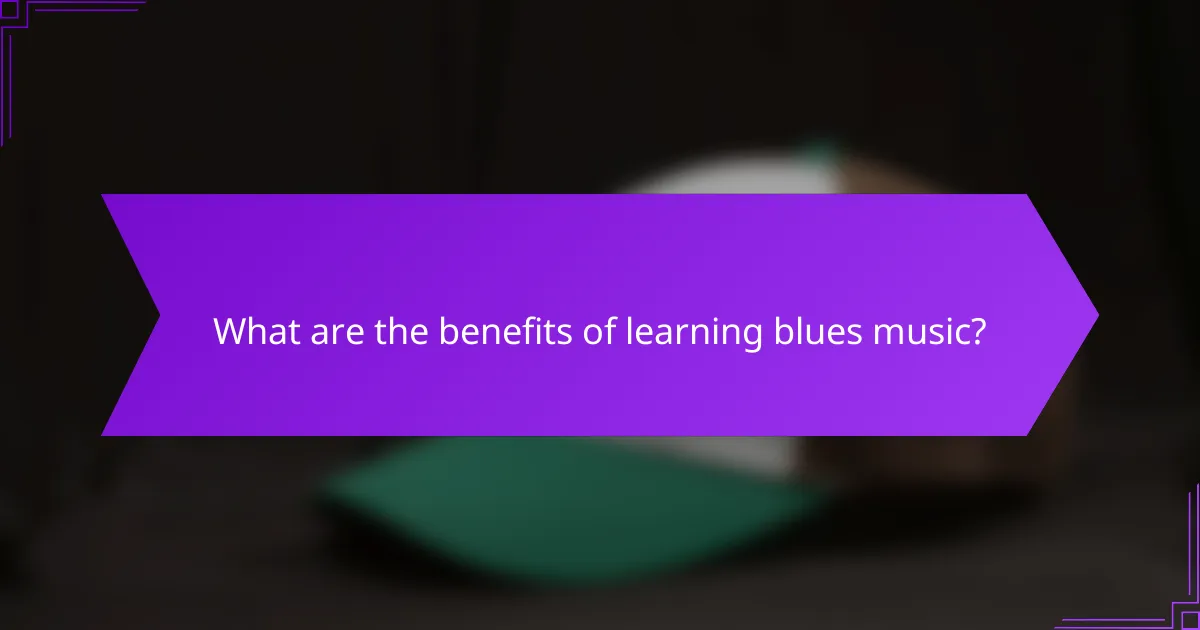
What are the benefits of learning blues music?
Learning blues music offers numerous benefits, including enhanced emotional expression and improved musical skills. It fosters personal storytelling through music, allowing individuals to connect deeply with their feelings and experiences.
Emotional expression through blues music
Blues music serves as a powerful medium for emotional expression. It allows musicians to convey complex feelings such as sorrow, joy, and resilience, often reflecting personal stories and struggles. This emotional depth can resonate with both the performer and the audience, creating a shared experience.
By learning blues, individuals can develop their ability to articulate emotions through sound. This can be particularly beneficial for those who find it challenging to express their feelings verbally, as music becomes an alternative outlet for communication.
Personal storytelling in blues
Blues music is rooted in storytelling, often drawing from personal experiences and cultural history. Musicians use lyrics and melodies to narrate tales of hardship, love, and triumph, making each performance unique and relatable. This narrative aspect encourages creativity and self-reflection.
When learning blues, aspiring musicians are encouraged to write their own lyrics, which helps them explore their own life stories. This practice not only enhances songwriting skills but also fosters a deeper understanding of their own emotions and experiences.
Building connections through blues
Engaging with blues music can help build connections with others, both within the music community and beyond. The shared experience of playing or listening to blues fosters camaraderie among musicians and fans alike. This sense of belonging can be particularly valuable for those seeking community or support.
Participating in jam sessions or local blues events can enhance these connections. Musicians can collaborate, share techniques, and learn from one another, creating a supportive environment that nurtures growth and creativity.
